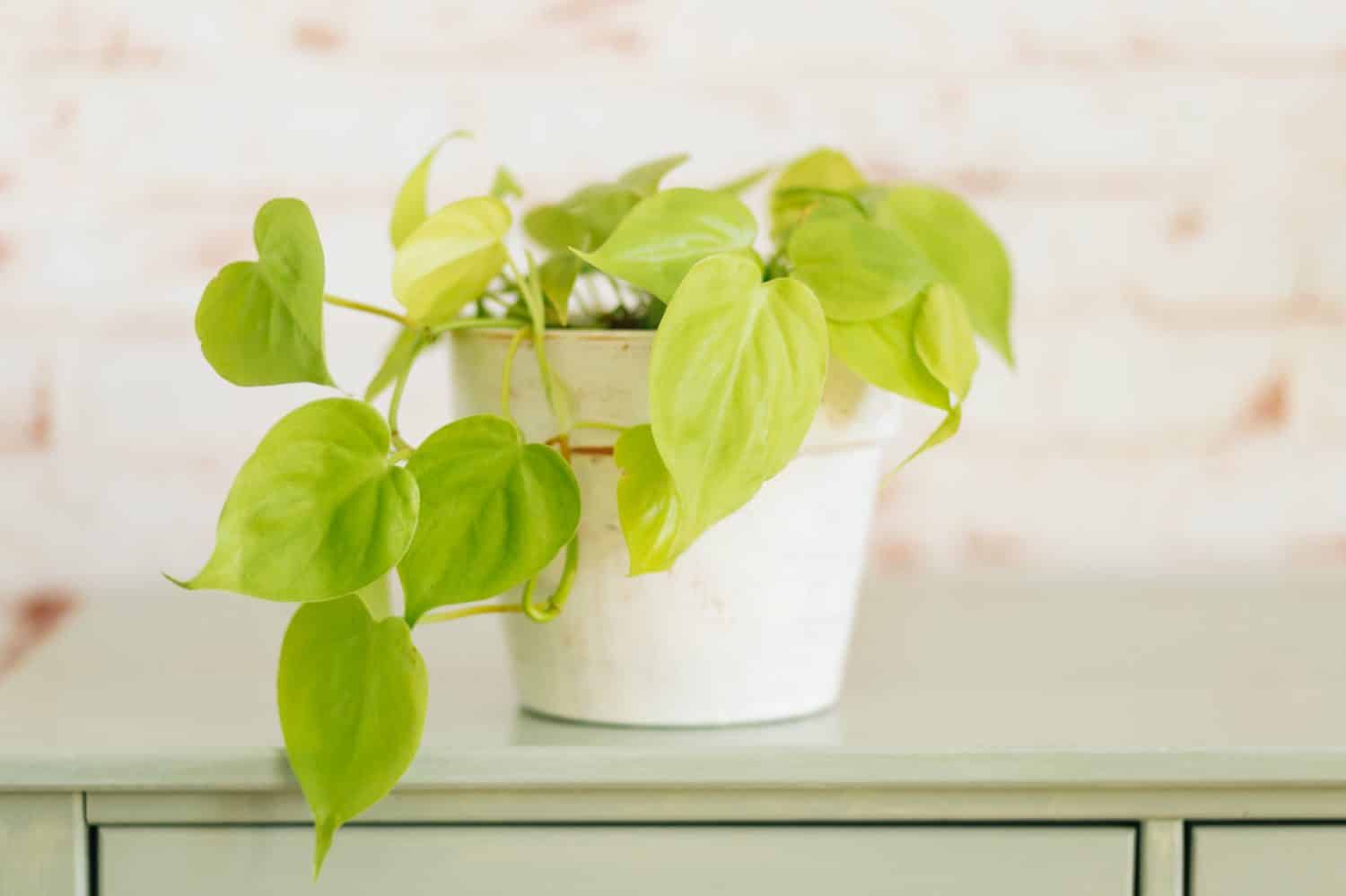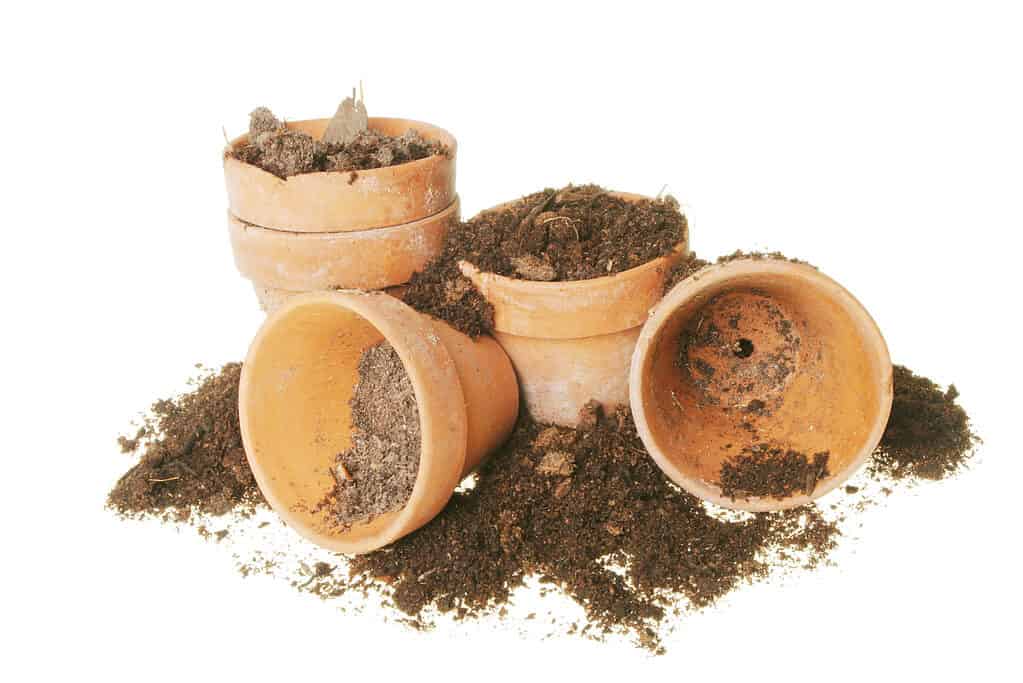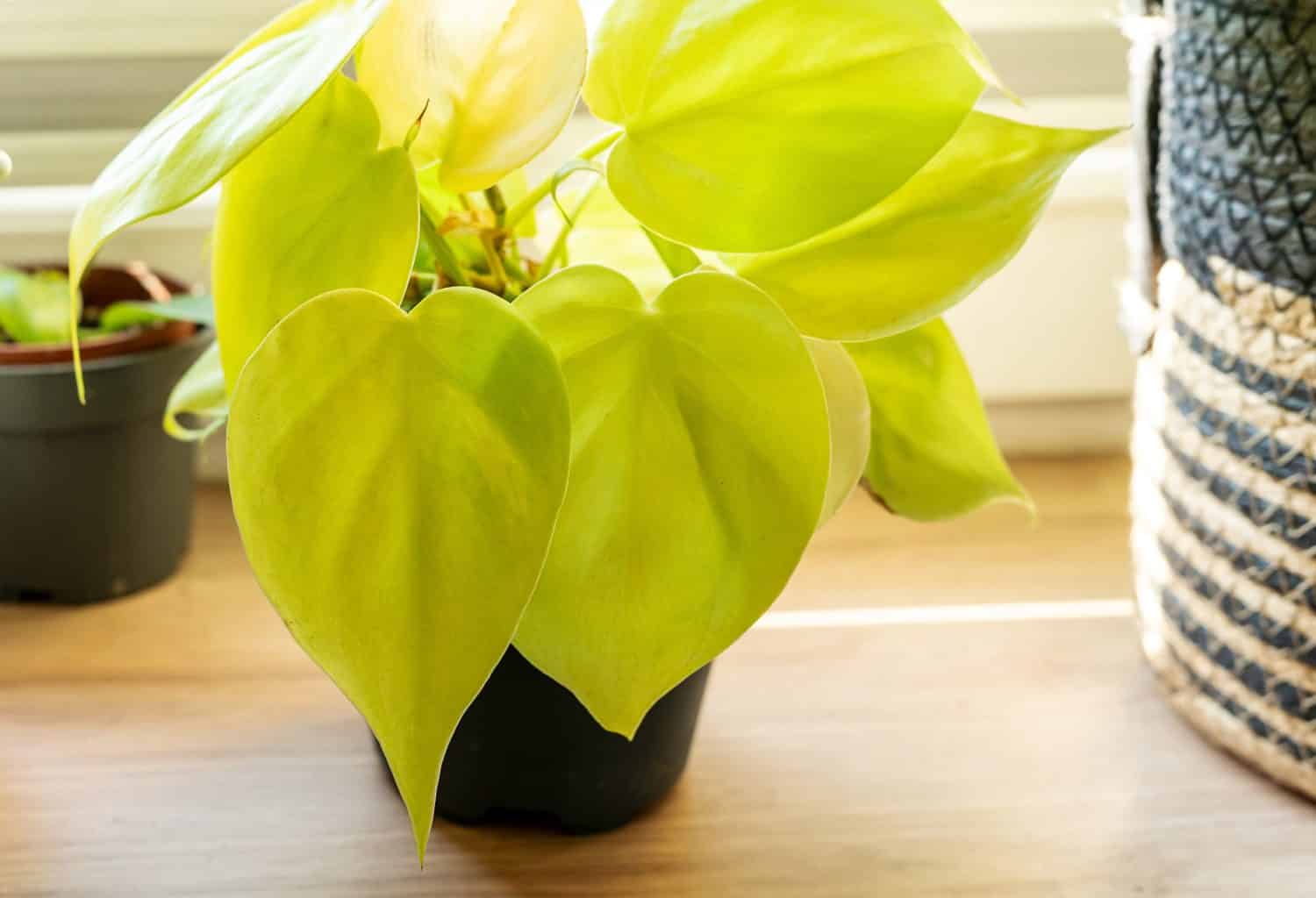If you like vibrant, energizing houseplants, you’ll love the philodendron lemon lime. This low-maintenance indoor plant adds a splash of color that brightens up any room without requiring too much time or attention.
In this article, we’ll cover how to care for a philodendron lemon lime and answer some commonly asked questions from beginner plant parents.
Let’s dig in!
What Are Philodendron Lemon Lime Plants?
Philodendron lemon lime plants are a cultivar of the Philodendron hederaceum species, also known as heartleaf philodendrons for their charming leaf shape.
This type of philodendron isn’t rare, but it is unique. Adding this vibrant cultivar to your indoor plant collection is a great way to stand out.

‘Lemon Lime’ is a vibrant yellow-green color with heart-shaped leaves.
©Julia Dresch/Shutterstock.com
Appearance
Lemon lime philodendrons have small heart-shaped leaves and a bright yellow-green color. They’re often confused for the neon pothos, which boasts a similar leaf shape and tone. However, philodendrons have a more distinct heart shape and several nodes, whereas the pothos is more rounded with a single node. Philodendron lemon lime is also more matte than the waxy neon pothos.
Native Regions
While the exact origin of this cultivar is unknown, the broader Philodendron hederaceum species originates in the tropical forests of Central America, stretching down into South America.
Uses
This vibrant philodendron is primarily used for decoration. The trailing foliage and climbing habits make it an excellent interior design element.
Toxicity
Like all philodendrons, the lemon lime is toxic to pets and humans. Keep this in mind if you have curious critters or children at home.
Plant Parent Experience Level
Philodendrons are a low-maintenance plant that can endure a bit of neglect, and the lemon lime is no exception. These qualities make this plant perfect for beginners.
1. Soil Requirements
Philodendron lemon lime requires a well-draining soil that retains a touch of moisture. In essence, it needs something that will hold water without waterlogging the roots and causing rot. Use regular potting soil with a bit of perlite or coco coir for airflow. Alternatively, you can find pre-mixed aroid soil for these plants.
2. Choosing the Right Pot
As long as your pot has drainage holes, you can get creative when potting your philodendron lemon lime. This resilient plant will thrive in ceramic, clay, plastic, or anything in between.

Philodendrons will grow in any type of pot that has ample drainage.
©iStock.com/Griffin24
3. Light Requirements
Philodendrons grow naturally in rainforests, which has dappled sunlight from the dense canopy overhead. When growing a philodendron lemon lime indoors, you should place it in bright, indirect sunlight. Direct sunlight will cause the soil to dry too quickly and could scorch the leaves.
4. Watering Requirements
Try not to let your lemon lime philodendron’s soil get dry. Check it weekly and determine if the top inch of soil is dry. If it is, it’s time for a good soaking. Plan to water less frequently during the winter months.
5. How and When to Fertilize
Give your lemon lime a nice feeding of organic matter in the spring to promote growth. This acidity-loving plant also responds well to coffee grounds during active growth.
6. Common Pests to Watch for
Philodendrons are susceptible to mealy bugs, scale insects, and spider mites — the usual suspects for indoor plants. Keep pests at bay by wiping down your philodendron leaves with a warm, damp cloth and dish soap. Use neem oil or fungicide if the pests return.
7. Signs of Distress to Watch for
Your philodendron lemon lime’s leaves should stay a vibrant yellow-green. If you notice browning, this could be a problem with sun scorching or soil that’s too dry. Gradually increase the watering frequency and re-evaluate your placement.
If the leaves are turning a bright sunny yellow, you may be overwatering your plant. Re-evaluate your watering frequency, and check to ensure your pot is draining properly.
If your leaves are curling, it could be a sign of cold damage. Ensure your plant isn’t in a place that dips below 60°F (15°C).
Finally, if your plant is generally looking unhealthy or blackening, check the roots for signs of rot. Cut away affected tissue, dispose of the soil, and repot immediately.
8. Pruning Requirements
Philodendron lemon lime doesn’t require pruning. However, cutting the plant back will help promote bushier growth. You can also prune away dying leaves, but determine the cause as you do so!

Pruning your philodendron lemon lime will help it grow bushier.
©Julia Dresch/Shutterstock.com
9. How and When to Propagate
Philodendrons are easy to propagate by division or stem cuttings. This is an excellent way to promote bushier growth and establish new plants.
- Prepare your space by laying out clean cutting tools and a new pot with soil.
- Water your philodendron lemon lime a few days before propagation for optimal health.
- Cut an established stem with several nodes.
- Place the cutting in a dry area out of direct sunlight for 2-3 days until the cutting callouses over.
- Dip the calloused end in rooting hormone.
- Plant the cutting in your new pot with prepared potting soil. The soil should be moistened.
- Place the new philodendron in indirect sunlight and water regularly until roots are established.
It will take a few weeks for your philodendron lemon lime cutting to get established. When it is, you can follow the care steps listed above.
The best time to propagate a philodendron is in the late spring, at the start of the growing season. Avoid propagating in the fall and winter to prevent lasting damage.
10. When and How to Repot
Philodendrons will do okay if they become a bit root-bound. However, you should aim to repot if you see roots poking out of the drainage holes. Alternatively, repot every 2-3 years to offer fresh soil nutrients.
11. How to Support Climbing
Philodendron lemon lime is an avid climber. Provide a moss pole, trellis, or wall clips to give its air roots something to grasp.
12. Proper Plant Placement
Philodendrons love the humidity of a well-lit bathroom. Place it near a sunny window with a few feet of grace to prevent scorching. Ensure you place this humidity-loving plant away from dry heat sources and drafty windows.
13. Leaf Care and Cleanliness
The leaves on philodendron lemon lime are prime for collecting dust. Wipe them down regularly to help avoid pest development and keep them fresh for photosynthesis.
14. Dormancy Preparation
Like many plants, philodendron lemon lime winds down in the fall and winter. Nutrients are redirected to the roots to prepare for the next growing season.
Avoid propagating during this time, as the plant won’t be active enough to redirect nutrients to heal the cutting. You should also avoid repotting your plant, as it won’t be as prepared to handle the transition shock.
Reduce watering frequency as the days get colder, testing the soil regularly for moisture. If the soil is still moist, avoid watering the philodendron.
Finally, avoid feeding your plant with organic matter or fertilizer toward the end of the growing season. Your philodendron may be unable to absorb all the nutrients, which could affect the soil and ultimately cause harm to the plant.

‘Lemon Lime’ will survive if slightly root-bound, but you should repot it.
©Chekyravaa/Shutterstock.com
15. Active Growth Preparation
Preparing your philodendron lemon lime for active growth essentially reverses the dormancy preparation process.
In the late spring or early summer, you’ll start increasing watering frequency again. Test the soil and avoid overwatering.
Provide your philodendron with some much-needed nutrients via a diluted fertilizer or organic matter.
If you plan to propagate, wait until your philodendron lemon lime wakes up a bit. Once it’s had a good feeding and is receiving regular watering, you can propagate, prune, or repot your plant.
The photo featured at the top of this post is © Julia Dresch/Shutterstock.com
Thank you for reading! Have some feedback for us? Contact the AZ Animals editorial team.







